
The “market” is not the economy
The economy can be viewed as yesterday’s consumption in data form. The current market index price is today’s expectations of future earnings. In this way the market is a discounting mechanism to bring the expected future cashflows into today’s values. So, with that in mind, it’s perfectly normal to see the two drift apart from each other and that is especially true in the current climate.
Dispersion peaks
Also misleading is the concept of “the market”. Many indices make up this global stock market and much news flow focuses on the S&P500 in the US. We feel the MSCI All Country index to be far more useful, but any measure has its limits. At the moment, any headline index is a tale of a thousand stories. Those stories are, however, radically dispersed in content and effect. Dispersion is a measure of the gap between winners (winning stocks and sectors) and losers (losing stocks and sectors). Below is a graph showing how dispersion has blown out recently.
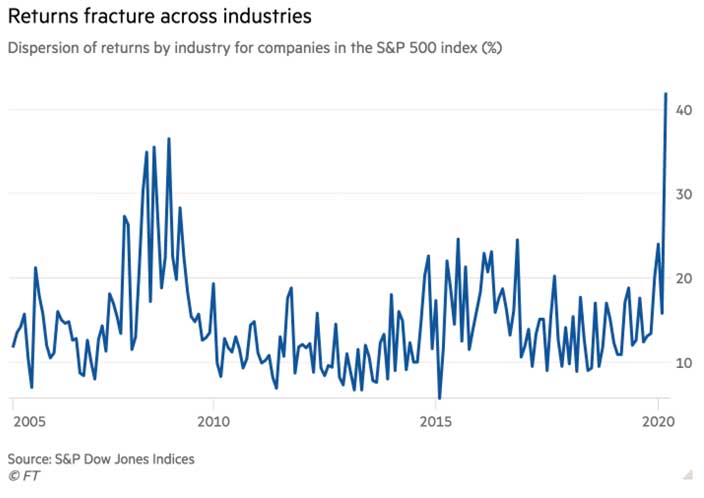
The above graph is sourced from and is the property of the Financial Times.
When dispersion spikes like this, we know the market is dealing with large amounts of uncertainty. This uncertainty is being magnified by the solvency vs liquidity dynamics of this crisis.
Radically different sector stories
Within the headline index price level recovery lie the different stories of the different sectors and how they have been affected by the global shutdown. Clearly the worst hit are airlines, but not far behind are energy, hospitality and property. E-commerce retailers like Amazon, along with technology and health / pharma sectors are almost back at pre-crisis price levels.
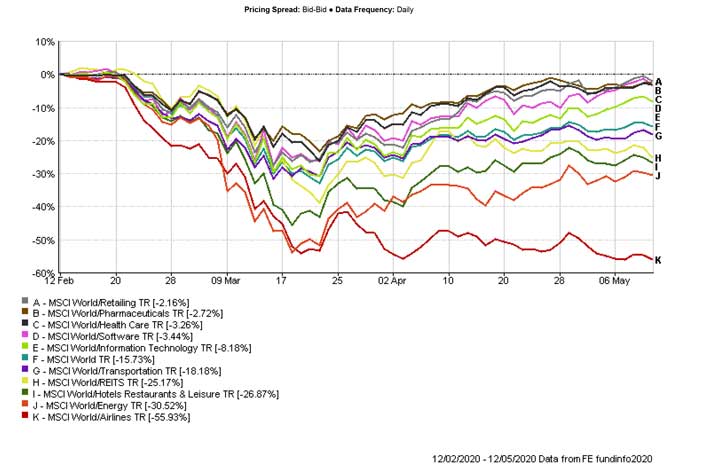
Our view is that mega tech and large cap health / pharma look considerably overpriced relative to the economic backdrop. The rest of the broader indices look well-priced on a five-year view. To see this better we should consider the “factor” lens view.
Value factor at record levels relative to growth:
Factor investing is a game of harvesting tiny differences between factors and the index and compounding over time. Therefore, big differences between factors and the index are unusual and usually not persistent. Our portfolios overweight value, small cap, ESG and profitability factors. The value factor is at levels not seen before and this follows almost 10 years of underperformance.
Companies that meet the value factor metric are ones that are below fair value on a price-to-book-valuation basis. This is one of the oldest forms of investing and was made famous by the Sage of Omaha himself. It accounts for much of the Berkshire Hathaway’s underperformance over the past decade. The value premium is the expected additional return available from such companies vs the index. It is not unusual for any factor to have long periods of underperformance. However, current levels are new records.
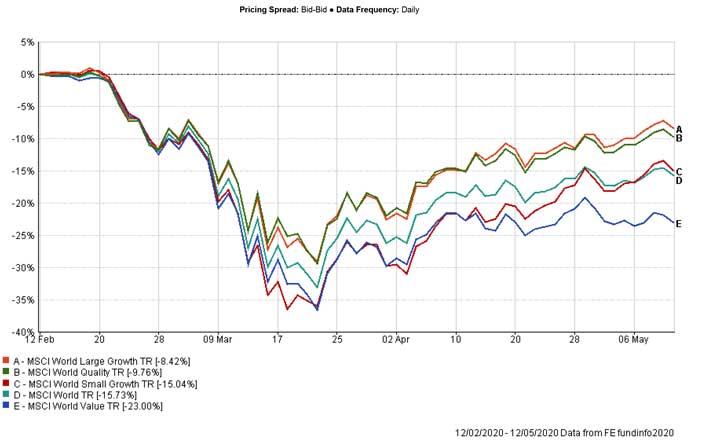
Is value dead?
Recent papers by the fathers of value (Eugene Fama and Kenneth French), Rob Arnott et al. of Research Affiliates, and Clifford Asness of AQR have all addressed this question. The results of these deep dives are eye opening. Below is a visual, compliments of Research Affiliates, showing you relative performance and relative valuation of value vs growth back to the 1960s. The long-term trend of performance of the value factor is clear (blue line) as is the recent underperformance. However, even more notable is the relative post-crisis performance. We feel this is notable especially when you consider that the global financial crisis was a balance sheet crisis whereas COVID-19 is more of a demand and supply crisis. On a relative basis (to growth) value currently sits in the 97th percentile on the distribution curve of valuation relative to growth. This is extreme cheapness of value vs growth.
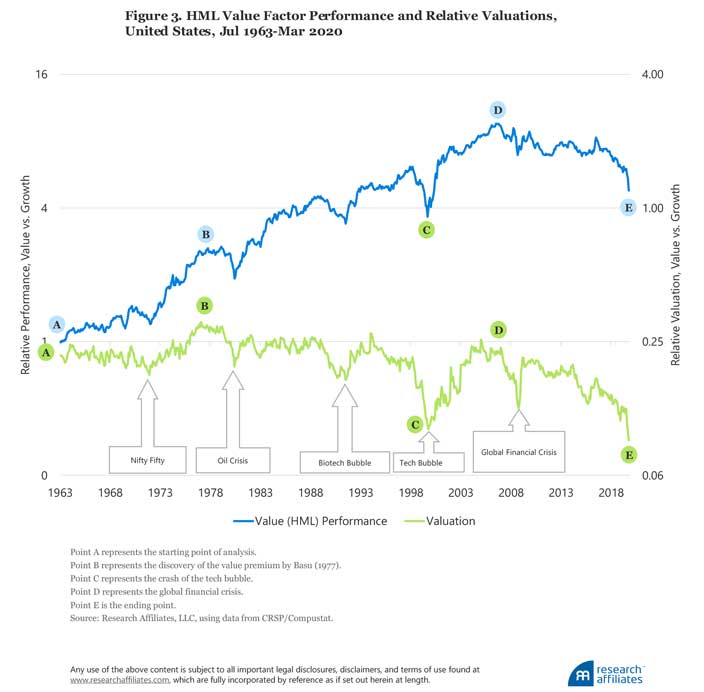
The above graph is sourced from and is the property of Research Affiliates.
What type of crisis? Solvency vs liquidity
What looks like good value depends on how one sees the crisis playing out over time. Scenario planning becomes less useful when your best and worst scenarios are on the opposite ends of the extreme. A key variable in these economic scenarios is the possible second wave of infection and subsequent second lockdowns. A 5% or 10% drop in GDP over a year are radically different outcomes with very different implications for recovery. PwC in the UK has offered the following scenarios for the UK showing a second wave of infection as doubling the impact on UK GDP.
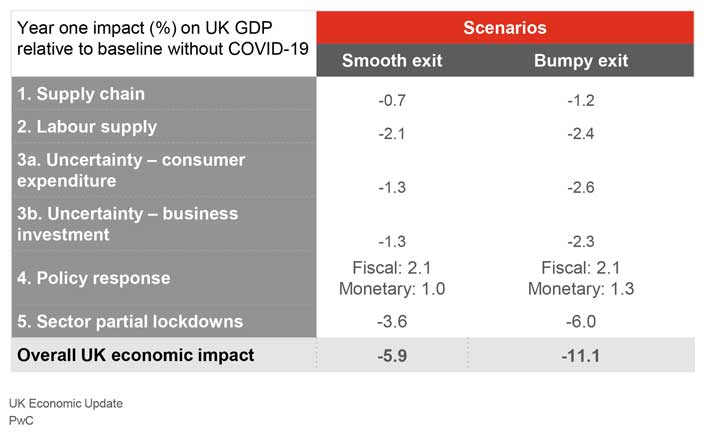
The above table is sourced from and is the property of PwC.
The large fiscal measures being applied by the US, UK and Europe are essentially liquidity stopgaps. However, the damage really begins if the crisis lingers on and becomes about solvency. The pricing opportunity in the value premium available now is reflecting this high degree of uncertainty.
Portfolio choices during COVID-19
As wealth managers, we build portfolios for long-term investors and we do so with a global view. In many ways our models have anticipated elements of this crisis for the simple reason that the crisis has accelerated previously existing trends. These are the move from retail to e-commerce, the aging of western baby boomers and the winner takes all aspect of large-scale innovation. Therefore, we’ve not had to do too much retrofitting to our models for this new reality. The approach in our models is built around the following key principles, which are very relevant today:
1. Diversify away single stock risks
Our core portfolios have 14,000 holdings across all the major investment indexes including emerging markets and debt markets. Low diversification at stock level can come at a high cost in this type of situation.
2. Value premium exposure
We access the value premium but only within the diversification framework set out above. This offers long-term investors a safety net to access this factor at historic levels.
3. Cost control:
With the distinct possibility of lower growth post crisis as we absorb higher taxes, bifurcated supply chains, and public sector indebtedness, keeping portfolio costs down becomes essential to compound returns over time.
4. Structural overlays
We use active managers sparingly to do conviction stock picking in a portion of our models to access a quality and innovation tilt. We access the health and pharma sector passively as a sector overlay. These mandates are wide enough to not be constrained by geographic or sectoral effects.
5. Entry price risk
With volatility levels across all asset classes and markets elevated, we’re advising new money be phased into the markets over the period of the dislocation and it’s immediate aftermath. This diversifies entry price risk and protects the downside for long-term investors.
Afterthoughts
Extreme uncertainty is never comfortable and I’m sure we all feel that discomfort. In advising clients, we try not to pretend to know the unknowable but instead endeavour to be on the right side of probabilities and compound over time. Good investing doesn’t yearn for certainty but makes calculated decisions on price opportunities. A respected fund manager I know has made a good career as a money manager out of being right 60% of the time. In this vein, consider also the risk of not investing at all. For some time before COVID-19 came along cash returns ran well below inflation. Even if worries about future inflation end up being overdone, continued negative real returns on cash are almost a given. You/we have no choice but to invest to generate a return. Here at Sable Wealth, we’ll continue to do our very best to help you do so sensibly.
